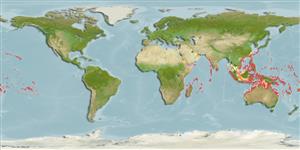Classification / Names
Common names from other countries
Main reference
Size / Weight / Age
Max length : 25.0 cm TL male/unsexed; (Ref. 11441)
Environment
Marine; reef-associated; depth range 0 - 40 m (Ref. 9710), usually ? - 30 m (Ref. 11441)
Climate / Range
Tropical, preferred ?; 30°N - 35°S, 25°E - 133°W
Distribution
Short description
Dorsal
spines
(total): 7;
Dorsal
soft rays
(total): 9;
Anal
spines: 2;
Anal
soft rays: 8. Characterized by having dorsal fin rays VI-I, 9; anal fin rays II,8; pectoral fin rays 12; pelvic fin rays I, 5; pored lateral line scales 25; predorsal scales 6; circumpeduncular scales 12; large canine-like teeth on jaws; preopercular margin serrated (Ref. 93839).; juveniles have a large black blotch on the caudal peduncle which becomes diffuse with age. Adults resemble adults of C. artus, but have wider stripes with darker interspace (Ref. 37816); characterized further by pale grey color; eight red-brown stripes on side, caudal fin base whitish; dark caudal fin margins; greatest depth of body 3.1-3.8 in SL (Ref. 90102).
IUCN Red List Status (Ref. 115185)
Threat to humans
Harmless
Human uses
More information
ReferencesAquacultureAquaculture profileStrainsGeneticsAllele frequenciesHeritabilityDiseasesProcessingMass conversion
Tools
Special reports
Download XML
Internet sources
Estimates of some properties based on models
Phylogenetic diversity index
PD50 = 0.5000 many relatives (e.g. carps) 0.5 - 2.0 few relatives (e.g. lungfishes)
Trophic Level
4.0 ±0.66 se; Based on food items.
Resilience
High, minimum population doubling time less than 15 months (Preliminary K or Fecundity.)
Vulnerability
Low vulnerability (25 of 100)
Price category
